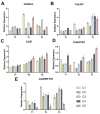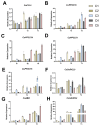Drought Resistance Evaluation of Camellia oleifera var. "Xianglin 210" Grafted onto Different Rootstocks
- PMID: 40872191
- PMCID: PMC12389222
- DOI: 10.3390/plants14162568
Drought Resistance Evaluation of Camellia oleifera var. "Xianglin 210" Grafted onto Different Rootstocks
Abstract
As a key economic tree in southern China, Camellia oleifera faces severe yield losses under drought. Grafting onto drought-tolerant rootstocks offers a potential mitigation strategy. To elucidate the impact of rootstocks on the drought resistance of the superior Camellia oleifera Abel. cultivar "Xianglin 210", grafted seedlings with five scion-rootstock combinations, were subjected to gradient drought stress. Key physiological and biochemical indices related to photosynthesis, antioxidant enzymes, and osmotic adjustment were measured. Drought resistance was comprehensively evaluated using membership function analysis, and the expression of stress-responsive genes was quantified via quantitative real-time PCR (qRT-PCR). The results demonstrated that under drought stress, (1) stomatal conductance (Gs) decreased by 31.2-48.7%, while instantaneous water use efficiency (WUE) increased by 18.5-35.4%; (2) proline (Pro) and soluble sugars (SS) accumulated significantly, with increases of 2.3-4.1-fold and 1.8-3.2-fold, respectively; (3) activities of antioxidant enzymes were enhanced by 56-127%, mitigating oxidative damage; (4) membership function analysis ranked drought resistance as follows: Xianglin 27 (0.812) > Guangxi Superior Germplasm (0.698) > C. yuhsienensis (0.654) > Hunan Superior Germplasm (0.591) > Xianglin 1 (0.523); (5) qRT-PCR revealed significant upregulation of ABA signaling pathway genes (CoPYL6, CoPP2C75/51/24/26, CoSnRK2.8, and CoABI5) and transcription factors (CoLHY and CoWRKY70), indicating activation of drought-responsive regulatory networks. These findings provide a theoretical foundation for selecting drought-tolerant rootstocks and optimizing cultivation practices in Camellia oleifera, and provide practical criteria for selecting drought-tolerant rootstocks, facilitating sustainable Camellia oleifera cultivation in water-limited regions.
Keywords: Camellia oleifera; comprehensive evaluation; drought stress; gene expression.
Conflict of interest statement
The authors declare no conflicts of interest.
Figures





Similar articles
-
Influence of different scion-rootstock combinations on sugars, polyamines, antioxidants and malondialdehyde in grafted grapevines under arid conditions.Front Plant Sci. 2025 Jun 27;16:1559095. doi: 10.3389/fpls.2025.1559095. eCollection 2025. Front Plant Sci. 2025. PMID: 40655552 Free PMC article.
-
Can high-throughput 3D and multispectral phenotyping detect early grapevine responses to water stress events?Plant Sci. 2025 Aug 18;360:112725. doi: 10.1016/j.plantsci.2025.112725. Online ahead of print. Plant Sci. 2025. PMID: 40829713
-
Physiological and Transcriptomic Mechanisms Underlying Vitamin C-Mediated Cold Stress Tolerance in Grafted Cucumber.Plants (Basel). 2025 Aug 2;14(15):2398. doi: 10.3390/plants14152398. Plants (Basel). 2025. PMID: 40805747 Free PMC article.
-
Advancements in Water-Saving Strategies and Crop Adaptation to Drought: A Comprehensive Review.Physiol Plant. 2025 Jul-Aug;177(4):e70332. doi: 10.1111/ppl.70332. Physiol Plant. 2025. PMID: 40599019 Free PMC article. Review.
-
Research progress and management strategies of fungal diseases in Camellia oleifera.Front Microbiol. 2023 Nov 23;14:1215024. doi: 10.3389/fmicb.2023.1215024. eCollection 2023. Front Microbiol. 2023. PMID: 38075888 Free PMC article. Review.
References
-
- Wang Y., Shi J., Liu K., Wang Y., Xu Y., Liu Y. Metabolomics and gene expression levels reveal the positive effects of teaseed oil on lifespan and aging process in Caenorhabditis elegans. Food Sci. Hum. Wellness. 2023;12:1391–1401. doi: 10.1016/j.fshw.2022.10.032. - DOI
-
- Zheng H., Chen F., Ouyang Z., Tu N., Xu W., Wang X., Miao H., Li X., Tian Y. Impacts of reforestation approaches on runoff control in the hilly red soil region of Southern China. J. Hydrol. 2008;356:174–184. doi: 10.1016/j.jhydrol.2008.04.007. - DOI
-
- Feng M., Zhang A., Nguyen V., Bisht A., Almqvist C., De Veylder L., Carlsbecker A., Melnyk C.W. A conserved graft formation process in Norway spruce and Arabidopsis identifies the PAT gene family as central regulators of wound healing. Nat. Plants. 2024;10:53–65. doi: 10.1038/s41477-023-01568-w. - DOI - PMC - PubMed
Grants and funding
LinkOut - more resources
Full Text Sources
Research Materials

